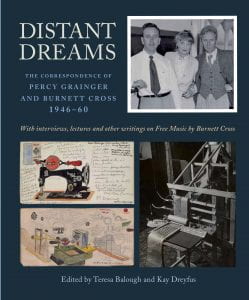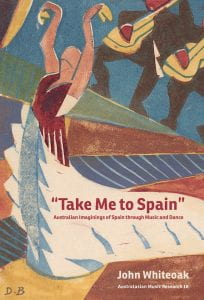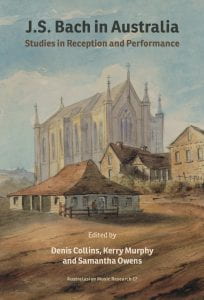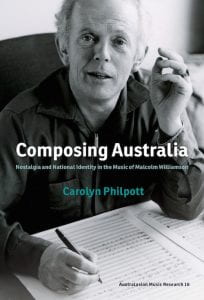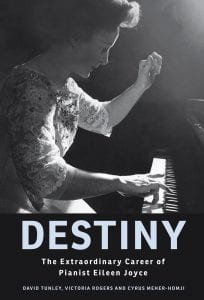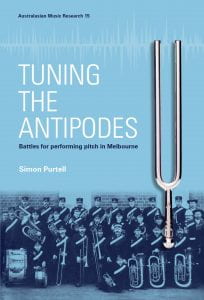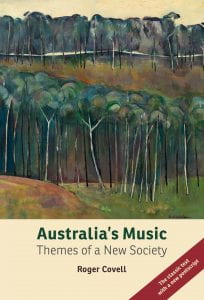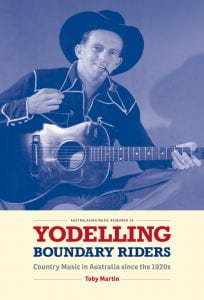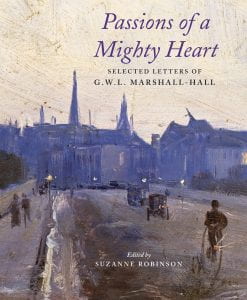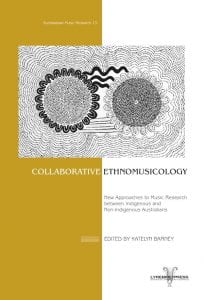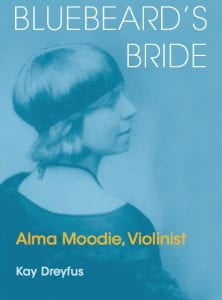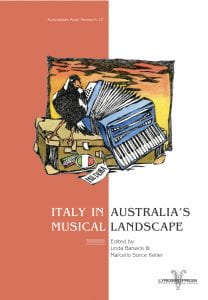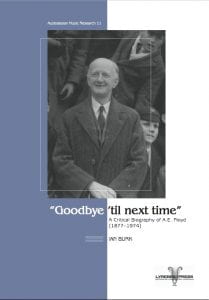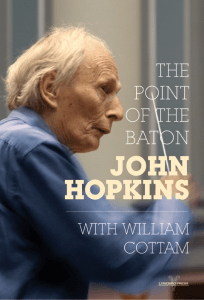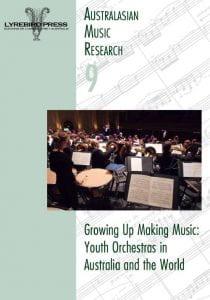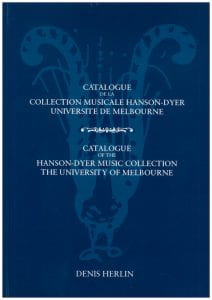BOOKS

FRITZ HART: AN ENGLISH MUSICAL ROMANTIC AT THE ENDS OF EMPIRE (AMR 21)
“This meticulously researched and detailed biography is … entertaining and accessible to non-specialists. Hart’s music and life, conclude Tregear and Forbes, have not just historical value but teach us something about our own”.
Barney Zwartz, Age (Melbourne), 24 April 2025
Fritz Bennicke Hart (1874–1949) stands as one of the more astonishing figures of the so-called English Musical Renaissance. This long-overdue biographical study explores and assesses the substantial and lasting contributions he made to the musical life of England, Australia and Hawai’i. As Tregear and Forbes have richly documented, Hart was a charismatic, and extraordinarily productive, composer, conductor, educator and institutional leader whose life-journey in music throws new light on the aesthetic concerns of early twentieth-century imperial Britain and how they were received and refracted at that empire’s farthest extent.
Peter Tregear (University of Melbourne and University of Adelaide) is the author of Ernst Krenek and the Politics of Musical Style (Scarecrow, 2013) and Enlightenment or Entitlement: Rethinking Tertiary Music Education (Currency House, 2014).
Anne-Marie Forbes (University of Tasmania) co-edited Joseph Holbrooke: Composer, Critic and Musical Patriot (Rowman & Littlefield, 2014) with Paul Watt, and Heart’s Ease: Spirituality in the Music of John Tavener (Peter Lang, 2020) with June Boyce-Tillman.
See this book in the online shop.
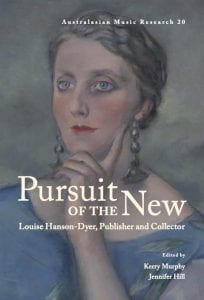
PURSUIT OF THE NEW: LOUISE HANSON-DYER, PUBLISHER AND COLLECTOR (AMR 20)
Edited by Kerry Murphy and Jennifer Hill (University of Melbourne). Including chapters by Kerry Murphy, Gerard Vaughan, Sarah Kirby, Catherine Massip, Susan Daniels, Rachel Orzech, Thalia Laughlin, Carina Nandlal, Madeline Roycroft and Isabelle Ragnard.
“What is most impressive … is the way in which these newly available documentary sources, as well as countless other now-published sources from Louise’s contemporaries, have been woven into major contributions to music and art histories, performance and recording practice, and the understanding of French artistic life during the Depression”.
Malcolm Gillies, Australian Book Review, April 2024.
This book on the Australian music publisher and patron Louise Hanson-Dyer brings together, for the first time, an international group of scholars with expertise in the history of early French musicology and sound recording; fine art and design; and critical editions and music publishing in France. With a focus on the interwar period, it aims to synchronise Hanson-Dyer’s Melbourne and Paris ventures, seeing her work in a global perspective and showing how she played a significant role in the transnational cultural relationship between Australia and France. Hanson-Dyer had vision and objectives and the drive to realise them; this volume situates the consolidation of her role as cultural activist in early twentieth-century Europe and Australia and presents new light on her publication of critical musical editions, her art collections and early sound recordings.
See this book in the online shop.
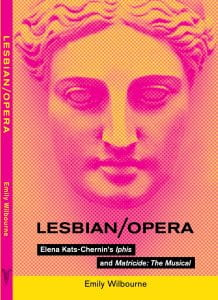
LESBIAN/OPERA: ELENA KATS-CHERNIN’S IPHIS AND MATRICIDE: THE MUSICAL
By Emily Wilbourne (City University of New York)
“a wonderfully written and thought-provoking read”
Jaslyn Robertson, Context 43 (2023)
Taking opera as an explicitly gendered phenomenon, Emily Wilbourne interrogates the position of the female composer in relationship to her work. With reference to Elena Kats-Chernin’s operas Iphis and Matricide: The Musical, both of which depict a lesbian relationship, and drawing upon interviews with the composer herself, Wilbourne produces an audacious analysis of the relationship of gender and opera, providing arresting insights into the work of one of Australia’s most admired composers.
See this book in the online shop.
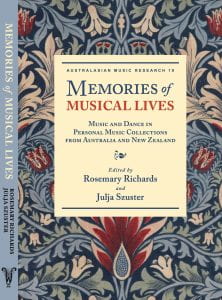
MEMORIES OF MUSICAL LIVES: MUSIC AND DANCE IN PERSONAL MUSIC COLLECTIONS FROM AUSTRALIA AND NEW ZEALAND (AMR 19)
Edited by Rosemary Richards and Julja Szuster with contributions from Julja Szuster, Rosemary Richards, Shane Lestideau, Kirstine Moffat, Clare Gleeson, Heather Blasdale Clarke, Elizabeth Nichol, Matthew Stephens, Aline Scott-Maxwell and John Whiteoak
“Memories of Musical Lives illuminates how personal musical collections may become a unique lens through which to reveal new dimensions in social history. The book explores a rich diversity of musical collections across a broad spectrum of musical genres and socioeconomic, class, religious, and gender distinctions”.
Jennifer Gall, Fontes Artis Musicae, July–September 2024
“This collection of essays, supported by extensive footnotes, an index, colour prints, and a bibliography of primary and secondary sources, takes the reader on a musical journey through this creative and formative period of our history. It breathes life into some of the characters of the time, individuals we may otherwise see simply as names on the dusty covers of neglected folios hidden away in piano stools”.
Duncan Stuart Warren Reid, Musicology Australia, January 2024
Music-lovers from Australia and New Zealand have collected and bound sheet music and handwritten music since the earliest years of settlement. In these nine essays, the authors discuss music and dance collections found in libraries, historic houses, archives and homes, explaining what these cherished artefacts reveal about the owners, their emotional life and their musical practice. Beautifully illustrated, and with suggestions for how these collections might be further explored or disseminated, this is a landmark book in the history of music in private life.
See this book in the online shop.
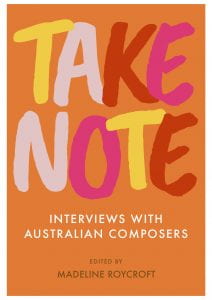
TAKE NOTE: INTERVIEWS WITH AUSTRALIAN COMPOSERS
Edited by Madeline Roycroft (University of Melbourne) with contributions from Patricia Shaw, Chris Dench, Martin Greet, Linda Kouvaras, Anna Goldsworthy, Jillian Graham, Wez Prictor, David Pereira, Stuart Greenbaum, Peter Campbell, Kat Nelligan, James Wade, Andrew Aronowicz, Madeline Roycroft, Maurice Windleburn, Jaslyn Robertson, Philip Eames, Laura Abraham, Robert McIntyre and Simone Maurer
What is the creative process? Is there an Australian voice? What place is there for tonality in music of this century? How does the performer contribute to the realisation of new music? These and many other questions relating to composition, its philosophy and individual works are answered by nineteen Australian composers in a fascinating collection of interviews dating from 1996 to 2021. Composers in the spotlight are: Larry Sitsky, Elena Kats-Chernin, Chris Dench, Julian Yu, Brenton Broadstock, Richard Mills, Nigel Westlake, Neil Kelly, Carl Vine, Elliott Gyger, Joseph Twist, Felicity Wilcox, Gordon Kerry, Liza Lim, Linda Kouvaras, Helen Gifford, Paul Stanhope, Stuart Greenbaum and Melody Eötvös.
See this free book in the online shop.
DISTANT DREAMS: THE CORRESPONDENCE OF PERCY GRAINGER AND BURNETT CROSS 1946–60 / With interviews, lectures and other writings on Free Music by Burnett Cross
Edited by Teresa Balough (Eastern Connecticut State University) and Kay Dreyfus (Monash University)
“A subtle volume with poignant depths”.
David Pear, Australian Book Review
Percy Grainger’s childhood imagining of a music capable of reproducing the sounds of nature was translated, in his later life, into the creation of wondrously inventive “Free Music” machines. Mostly made from found materials, these machines take their place in a proud tradition of sound art, at a point where the aural and the visual intersect.
Two minds converged on the creation of the machines: the one self-taught and intuitive, the other scientifically trained and rigorous. The exchange of letters between the two men charts their journey of discovery and the friendship that grew from it: a grand passionate human adventure.
See this book in the online shop.
“TAKE ME TO SPAIN”: AUSTRALIAN IMAGININGS OF SPAIN THROUGH MUSIC AND DANCE (AMR 18)
By John Whiteoak (Monash University)
“a significant contribution to Australian popular music history and the somewhat hidden, yet complex, place of Spain in that history’
Matthew Machin-Autenrieth, Popular Music History
“a ground-breaking book, which brings together an impressive range of sources
to deliver a long-scale narrative about Australia’s engagement with
Spanish music and dance”.
Ken Murray, (University of Melbourne), Musicology Australia
“a compelling and welcome addition to both Australian cultural history and
contemporary studies on ‘Spanishness’ and ideas of Spain”.
Nicholas Manganas (UTS), Journal of Australian Studies
Australians have been transported to an imaginary Spain from at least the 1830s, when cachuchas were first danced on the Sydney stage. In Take Me to Spain John Whiteoak explores the rich tapestry of Australians’ fascination with all things Spanish, from the voluptuous sensuality of Lola Montez to operas featuring señoritas, toreadors and Gypsies, and from evocative silent and later Spain-themed Hollywood movies to the dazzlingly creative artistry of the flamenco dancers and guitarists who toured Australia in the 1960s and ’70s. Examining the diverse ways that Spanish music and dance have been mediated or hybridised to cater for Australian popular taste, this landmark study of cross-fertilisation and ethnic fusion reveals how Hispanic traditions have become integral to the cultural history of the nation.
See this book in the online shop.
Read more on Google Books
J.S.BACH IN AUSTRALIA: STUDIES IN RECEPTION AND PERFORMANCE (AMR 17)
Edited by Denis Collins (University of Queensland), Kerry Murphy (University of Melbourne) and Samantha Owens (Victoria University of Wellington) with contributions from Janice B. Stockigt, Andrew Frampton, Alan Maddox, Julja Szuster, Peter Tregear, Samantha Owens, Niki Ebacioni, Peter Campbell, Ian Burk, Graham Lieschke and Heinz L. Kretzenbacher
This book is the first to be dedicated to a study of the reception of a European composer in Australia. Each of the eleven essays explores how J.S. Bach’s music has enriched Australian cultural life, from private performances in the early nineteenth century to historically informed realisations in recent years. The authors outline the challenges of mounting and sustaining this repertoire in the face of underdeveloped musical infrastructure and limited resources, and how these challenges have been overcome with determination and insight. Championed by imaginative individuals such as Ernest Wood and Leonard Fullard in Melbourne, E.H. Davies in Adelaide and W. Arundel Orchard in Sydney, Bach’s music has been a vehicle for the realisation of Australians’ cultural aspirations and a means of maintaining connections with traditions that continue to be cherished today.
See this book in the online shop.
Read more on Google Books
COMPOSING AUSTRALIA: NOSTALGIA AND NATIONAL IDENTITY IN THE MUSIC OF MALCOLM WILLIAMSON (AMR 16)
By Carolyn Philpott (University of Tasmania)
“Philpott is a sympathetic guide to the intersection of [Williamson’s] music
and Australian identity. She is also a patient, authoritative writer and a
persuasive advocate for Williamson’s music”.
Michael Hooper, Notes, December 2020.
Brilliant, provocative, compassionate—the composer Malcolm Williamson was one of Australia’s most famous expatriates. But as Carolyn Philpott explains, his nostalgia for his homeland lasted fifty years, from his emigration in 1953 until his death in 2003. In works such as the ballet The Display, Symphony no. 6 and The Dawn Is at Hand he explored inventive ways of expressing his Australian identity, collaborating with Australian artists, paying homage to Australian musicians and exposing his sorrow for the treatment of Indigenous peoples. As the first book-length examination of Williamson’s music, Composing Australia is a portrait of an intriguing and always imaginative Australian.
See this book in the online shop.
Read more on Google Books
DESTINY: THE EXTRAORDINARY CAREER OF EILEEN JOYCE
By David Tunley (UWA), Victoria Rogers and Cyrus Meher-Homji
“scrupulously researched and highly readable”
Rosalind Appleby, Australian, 7 April 2018.
Born in Tasmania, the Australian pianist Eileen Joyce was destined for the great concert halls of the world and a career that established her at the international pinnacle of twentieth-century pianism. In-depth essays in this book examine her studies in Germany, her appearances as a glamorous concert artist, her starring roles on film, her fascination with the harpsichord and embrace of early music, and her many acclaimed recordings. With listings of Joyce’s concerto and solo recital repertoire and the most complete discography to date, this is an informative new account of the extraordinary career of a consummate artist.
See this book in the online shop.
Read more on Google Books
TUNING THE ANTIPODES: BATTLES FOR PERFORMING PITCH IN MELBOURNE, 1850 TO THE PRESENT (AMR 15)
By Simon Purtell (University of Melbourne)
Examining the many controversies associated with pitch standards in Melbourne over more than a hundred years, Simon Purtell discovers their impact on the tuning of the city’s orchestras and organs, as well as its defence, municipal and Salvation Army bands. This fascinating history involves famous local and touring singers, conductors and organists, including Nellie Melba, Malcolm Sargent and William McKie, revealing just how complex a problem it was to ensure that Melbourne’s music-makers remained in tune.
See this book in the online shop.
Read more on Google Books
AUSTRALIA’S MUSIC: THEMES OF A NEW SOCIETY (2nd edition)
By Roger Covell (University of New South Wales)
Described on its first publication in 1967 as “a scholarly account of Australian music that is also entertaining social history”, Roger Covell’s Australia’s Music has become a classic of Australian music history for its beautifully written explorations of almost 200 years of music-making across classical, indigenous and Anglo-Celtic traditions. This revised edition of the classic text, including more than 60 musical examples, is supplemented by a new postscript written by the author.
See this book in the online shop.
Read more on Google Books
YODELLING BOUNDARY RIDERS: COUNTRY MUSIC IN AUSTRALIA SINCE THE 1920S (AMR 14)
By Toby Martin (University of Sydney)
This landmark book by Toby Martin tells the story of one of the most enduring forms of popular culture in Australia. Prior to the 1950s, country music was called hillbilly music. Hillbilly was the rock ’n’ roll of its day. The latest craze, straight from America, it was young, exciting and glamorous. This book traces the journey hillbilly took to become country: the rural, nationalistic form it is known as today.
Yodelling Boundary Riders is the first book to contextualise country music into a broader story about Australian history. Not just concerned with the development of the music itself, it is also a history of the ways in which Australians have responded to the rapid rate of change in the twentieth century and the global fascination with “authenticity”.
True to its subject matter, the writing is colourful and entertaining. Along the way Martin introduces some wonderful characters and events: yodelling stockmen, singing cowgirls, sentimental cowboys, coo-ees in Nashville, hobos on the mail train, the Sheik of Scrubby Creek and Australia’s craziest hillbillies.
See this book in the online shop.
Read more on Google Books
PASSIONS OF A MIGHTY HEART: SELECTED LETTERS OF G.W.L. MARSHALL-HALL
Edited by Suzanne Robinson (University of Melbourne)
Spanning two decades of the cultural life of Melbourne, from 1891 until the start of World War I, this collection of the letters of the composer, conductor and critic G.W.L. Marshall-Hall samples the scandal, disappointments, achievements and camaraderie of those years. Sometimes caustic and often opinionated, the letters expose their author’s infectious enthusiasm for Art as well as his tendency to rile his enemies. Gathered here from public and private archives in Australia and Britain are 249 of the extant letters, each of which offers a vivid portrait of a man many described as a musical genius.
See this book in the online shop.
Read more on Google Books
COLLABORATIVE ETHNOMUSICOLOGY: NEW APPROACHES TO MUSIC RESEARCH BETWEEN INDIGENOUS AND NON-INDIGENOUS AUSTRALIANS (AMR 13)
Edited by Katelyn Barney (University of Queensland)
Collaborative Ethnomusicology explores the processes, benefits and challenges of collaborative ethnomusicological research between Indigenous and non-Indigenous people in Australia. While there are many examples of research and recordings that demonstrate close collaboration between Indigenous and non-Indigenous Australians, this volume is the first to focus on the ways these processes allow Indigenous and non-Indigenous music researchers to work together and learn from each other. Drawing on case studies from across Australia, each chapter brings significant insights into the many positives and some of the discomforts in collaborative spaces, highlighting the ongoing dialogue needed in order to improve relationships between Indigenous and non-Indigenous people and inform the future of ethnomusicological research in Australia.
See this book in the online shop.
Read more on Google Books
BLUEBEARD’S BRIDE: ALMA MOODIE, VIOLINIST
By Kay Dreyfus (Monash University)
Alma Moodie is perhaps the most gifted violinist ever to have left Australia, acclaimed in Germany in her youth as a “rare apparition in the world of virtuosity”. Born in Mount Morgan, Queensland, in 1898, Moodie left Australia when she was nine for studies in Brussels with internationally renowned teachers. Through the tumultuous years of the First World War, the Weimar Republic and the Third Reich she forged an exceptional career, playing with the likes of the Berlin Philharmonic Orchestra under conductors including Nikisch, Furtwängler and Fritz Busch. Her untimely death in 1943 suggests that she was a victim of war just as surely as those many others whose fates were less ambiguous. By all accounts a charismatic personality and a prodigious musician, she left no recordings and has slipped into an obscurity as deep as it is undeserved. In piecing together the details of Moodie’s life, Kay Dreyfus reclaims her reputation as one of the outstanding violinists of her generation and as a leading exponent of the contemporary music of her day.
See this book in the online shop.
ITALY IN AUSTRALIA’S MUSICAL LANDSCAPE (AMR 12)
Edited by Linda Barwick (University of Sydney) and Marcello Sorce Keller
One in twenty Australians has ancestral connections to Italy, connections that continue to be activated today through music as well as through language, food and sociality. This volume brings together a collection of essays tracing the diverse origins of the musical practices brought by Australia’s Italians and the subsequent influences of commercial music, government policies, and ongoing transnational relationships with family and paesani (those from the same town or village). Responses by scholars from Italy and elsewhere in the Anglophone diaspora provide additional perspective on the significance of these phenomena.
See this book in the online shop.
“GOODBYE ‘TIL NEXT TIME”: A CRITICAL BIOGRAPHY OF A.E. FLOYD (1877–1974)
By Ian Burk (Australian Catholic University)
A.E. Floyd (1877–1974) had the ability to make music interesting and accessible to the musical public. By the 1940s, he was a household name in Australia particularly as a result of his music broadcasts, which always ended with the words ‘and now I’ll say goodbye ’til next time’. Under his direction, music at St Paul’s Cathedral, Melbourne, enjoyed an international reputation for excellence.
This book traces the life and work of a colourful, sometimes contradictory and legendary character: his early musical development in the United Kingdom and his subsequent work as cathedral organist, conductor, composer, music critic, broadcaster and educator.
See this book in the online shop.
THE POINT OF THE BATON
By John Hopkins, with Will Cottam
The Point of the Baton: Memoir of a Conductor (John Hopkins, with William Cottam) is the personal and surprisingly candid story of John Hopkins, from his first cello lesson at sixteen, to Chief Conductor of the BBC at 24, “Mr. Music” of New Zealand, Federal Director of ABC music, founding Dean of Music at the Victorian College of the Arts, Director of the Sydney Conservatorium of Music, and ever an inspiring teacher. This story recounts his experience with divas and artists—Stravinsky, Te Kanawa, Ashkenazy, Arrau, Menuhin, Kodály, and Oistrakh—and his experiences conducting in Soviet Moscow, in Mao’s China, and of taking orchestral music to the dangerous townships of South Africa immediately after apartheid ended.
See this book in the online shop.
UP IS DOWN: A LIFE OF VIOLINIST JAN SEDIVKA (AMR 10)
By Elinor Morrisby
Jan Sedivka, violinist and pedagogue, has been a towering figure in string playing in Australia for over forty-five years. This is Sedivka’s story: it encompasses the ups and downs of his extraordinary life.
Born in Czechoslovakia in 1917, Sedivka’s precocious gift for the violin led him to study with renowned Czechoslovak masters, Otakar Ševcík and Jaroslav Kocian. Aged twenty-one, he accepted a scholarship to study in Paris but this was truncated by the outbreak of World War II. As a result of the invasion, he spent six months in a Paris prison in appalling conditions before escaping to England to become a leading performer and highly sought-after teacher.
In 1961, Sedivka accepted a position at the Queensland Conservatorium of Music and migrated to Australia with his wife Beryl, violoncellist Sela Trau, and the Czech woman who had nursed him back to health in London. Victim of a “witch-hunt” and subject to police surveillance, Sedivka left Brisbane and since 1966 he has made his home in Tasmania where he established the finest string school Australia has ever known. Loyal, contrary, enigmatic, philosophical and verbose, Sedivka is also a consummate artist whose life was, and continues to be, devoted to music, his wife, and his students.
See this book in the online shop.
GROWING UP MAKING MUSIC: YOUTH ORCHESTRAS IN AUSTRALIA AND THE WORLD (AMR 9)
Edited by Margaret Kartomi
Growing up Making Music is the first detailed scholarly study of youth orchestras. Led by a team of researchers from Monash University in Australia, it focuses on the lives, aims, repertory, economics and educational outcomes that orchestras set out to develop. Focusing mainly on the Australian Youth Orchestra, the study also discusses orchestras from other parts of the world, including North American youth orchestras and the West-Eastern Divan Orchestra established by Daniel Barenboim and the late Edward Said. This study is an important and new endeavour that is essential reading for youth orchestra personnel, music educators and researchers.
See this book in the online shop
CATALOGUE OF THE HANSON-DYER MUSIC COLLECTION—UNIVERSITY OF MELBOURNE
Edited by Denis Herlin
For seventy-five years the music collection amassed by Éditions de l’Oiseau-Lyre’s founder, Louise B. M. Dyer—later Louise Hanson-Dyer—remained a private collection. As part of the on-going relationship between the press and the University of Melbourne, this collection has now been transferred to the Louise Hanson-Dyer Music Library at the University and is now accessible to musicians, researchers and scholars. The collection comprises some 250 prints and manuscripts dating from the 15th to the early 19th centuries. It is particularly notable for its collection of French operatic works, British publications, works of the Italian renaissance and books on music theory. The collection has been meticulously catalogued by Denis Herlin and includes a substantial introduction (in French and English) and over 50 black and white plates.
